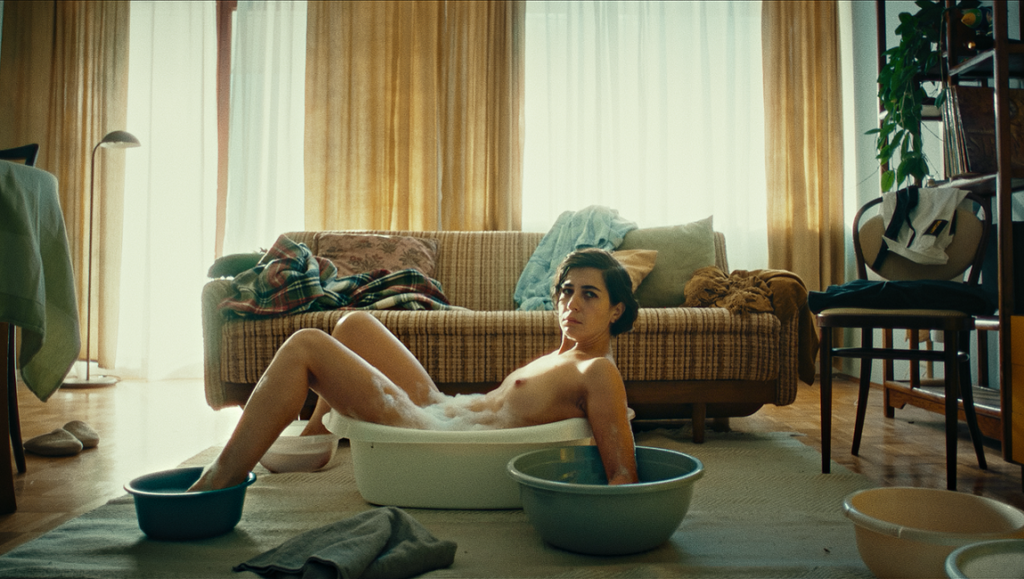Natalia Sinelnikova’s We Might As Well Be Dead begins with a bedraggled family slowly traversing a long road through dense forest, a towering high rise perched in the middle of the woods looming far in the distance. It’s an ominous opening, the stuff of fairytales perhaps, and upon their arrival at this mysterious destination they are immediately subjected to an intense security screening via a very serious-looking guard, Anna (Ioana Iacob). She asks a battery of questions while waving a metal detector wand up and down their bodies, somewhere between a TSA agent and a militarized realtor. It soon becomes clear that these people are not merely potential tenants of this glistening tower, but are in fact auditioning for a place amongst the other residents. Vague, portentous details about the outside world emerge, as the desperate father gets on his knees to beg admittance for himself and his wife and child, “for their safety.” Anna looks on dispassionately, suggesting that such an outlandish display of naked emotion could appear unfavorable to the acceptance committee. Here, dispassionate pragmatism rules the day, or so Anna claims. It slowly sinks in that we are in the land of allegory; this well-appointed high rise acting as a synecdoche for society in general, a kind of metaphorical battleground for real-world anxieties to play themselves out in microcosm. In other words, we’re in J.G. Ballard’s world, a la High Rise and even Super-Cannes, his other novel about gated communities harboring dark secrets and perverse conspiracies. This is skyscraper-as-social-stratification, a literal manifestation of stacked hierarchies and castes, complete with a basement-dwelling undesirable. It’s never explicitly stated what exactly lies beyond the razor wire fencing of this ensconced compound, only hushed utterances of fear and a steadfast desire to never return to it. Instead, a committee of banal-looking executive-types rules over everything with an iron fist and a pleasant smile. Anna is their enforcer, although the bulk of the film will detail just how precarious her position really is.
There’s a lot going on here, as Sinelnikova flits between broad-strokes social commentary and more lived-in, realistic human behavior. Formally, We Might As Well Be Dead lands squarely on the Haneke spectrum, with clinical sparseness and precise framings that isolate people within the elaborate architecture of the building. There’s also a dash of Lanthimos sprinkled here and there, a deadpan, darkly comic sensibility that mines humor from the weird and exaggerated. Anna’s daughter, Iris (Pola Geiger), won’t leave the bathroom, and only interacts with her mother through a vent opening. An odd man rides up and down the elevators all day selling poetry to the residents, the tower’s sole nod toward a dispossessed underclass. An army of pasty white middle-aged retirees plays golf in disarming synchronicity, while the committee organizes some annual performance gala (the only thing that seems to resemble the arts or entertainment here). Of course, this carefully constructed simulacrum must be disrupted, and it comes in due course by Anna herself — quite accidentally, she interrupts some tenant’s bizarrely ritualized foreplay routine while searching for a lost dog. Anna runs away, embarrassed, but the tenants become convinced that an interloper from outside the fences has somehow infiltrated their sanitized pseudo-utopia. Demanding results from their security guard, Anna is in effect tasked with hunting herself down, something she obviously chooses not to do. While she works to calm the residents and reassure them that their sanctuary is secure, fear turns to paranoia, with certain agitators now convinced that it must be one of their own who has turned against them.
Sinelnikova makes her point quite bluntly when a woman informs Anna that “the appearance of safety is just as important as safety itself.” To the fear-mongering paranoiacs safely ensconced indoors, even the slightest perturbation is cause for alarm. If this all feels a bit labored and predetermined, one need only look at the recent recall election in San Francisco for an applicable real-world analog. Sinelnikova also smartly observes how quickly the well-off turn against the weak, abusing the elevator vagrant and even attacking Anna with passive-aggressive reminders that she’s an outsider, “no matter how well she speaks the language” (Iacob is Romanian, lending this German film an additional layer of immigration subtext). We Might As Well Be Dead isn’t a slam dunk; much of this is well-trod material, a familiar allegorical construct critiquing well-established societal ills. But the cast is uniformly excellent, and anchoring it all is Iacob, turning in another fine performance after several collaborations with Radu Jude (most notably in I Do Not Care If We Go Down in History As Barbarians). Sinelnikova, working with cinematographer Jan Mayntz, has a great eye for imposing, off-kilter compositions and ominous negative spaces, and largely on the strength of this artistic instinct, the film thankfully never devolves into the kind of anarchic violence that characterizes many of these dystopian projects, a la Ben Wheatley’s misguided adaptation of High Rise from some years back. While certainly bleak, Sinelnikova allows her characters at least some amount of resilience even in the face of an uncaring, racist upper-class that prefers hiding from problems instead of fixing them.
Published as part of Tribeca Film Festival 2022 — Dispatch 1.


Comments are closed.